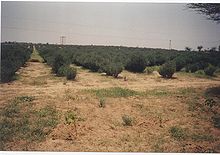Desertification
This is driven by a number of factors, alone or in combination, such as drought, climatic shifts, tillage for agriculture, overgrazing and deforestation for fuel or construction materials.
[5] This situation is exacerbated by land degradation because of the reduction in productivity, the precariousness of living conditions and the difficulty of access to resources and opportunities.
[6] Geographic areas most affected are located in Africa (Sahel region), Asia (Gobi Desert and Mongolia) and parts of South America.
Methods of mitigating or reversing desertification include improving soil quality, greening deserts, managing grazing, and tree-planting (reforestation and afforestation).
Definition by UNO (1995) – Land degradation in barren, humid and sub-humid areas due to climate change and human activities is called desertification.
[11] The most widely accepted of these was that of the Princeton University Dictionary which defined it as "the process of fertile land transforming into desert typically as a result of deforestation, drought or improper/inappropriate agriculture".
This is driven by a number of factors, alone or in combination, such as drought, climatic shifts, tillage for agriculture, overgrazing and deforestation for fuel or construction materials.
[20] Such variations influence the strength of the West African Monsoon, inducing feedback in vegetation and dust emission that amplify the cycle of wet and dry Sahara climate.
[23] The study found that, between 1982 and 2015, 6% of the world's drylands underwent desertification driven by unsustainable land use practices compounded by anthropogenic climate change.
For example, dust storms in the Middle East “are becoming more frequent and intense in recent years” because “long-term reductions in rainfall [cause] lower soil moisture and vegetative cover”.
[29] The violent herder–farmer conflicts in Nigeria, Sudan, Mali and other countries in the Sahel region have been exacerbated by climate change, land degradation and population growth.
[5] This situation is exacerbated by land degradation because of the reduction in productivity, the precariousness of living conditions and the difficulty of access to resources and opportunities.
[6] Many underdeveloped countries are affected by overgrazing, land exhaustion and overdrafting of groundwater due to pressures to exploit marginal drylands for farming.
When unfavorable agri-climatic conditions are combined with an absence of infrastructure and access to markets, as well as poorly adapted production techniques and an underfed and undereducated population, most such zones are excluded from development.
[47][48] The climate of the Sahara has undergone enormous variations over the last few hundred thousand years,[49] oscillating between wet (grassland) and dry (desert) every 20,000 years[50] (a phenomenon believed to be caused by long-term changes in the North African climate cycle that alters the path of the North African Monsoon, caused by an approximately 40,000-year cycle in which the axial tilt of the earth changes between 22° and 24.5°).
[52] Lake Chad, located in the Sahel region, has undergone desiccation due to water withdrawal for irrigation and decrease in rainfall.
[56] The purpose of this mammoth planting initiative is to enhance retention of water in the ground following the seasonal rainfall, thus promoting land rehabilitation and future agriculture.
[58] Although the Gobi Desert itself is still a distance away from Beijing, reports from field studies state there are large sand dunes forming only 70 km (43.5 mi) outside the city.
An estimated 13% of desertification in Mongolia is caused by natural factors; the rest is due to human influence particularly overgrazing and increased erosion of soils in cultivated areas.
[64] In addition, the Mongolia government has listed forest fires, blights, unsustainable forestry and mining activities as leading causes of desertification in the country.
[65] The transition from sheep to goat farming in order to meet export demands for cashmere wool has caused degradation of grazing lands.
[66] To mitigate the financial impact of desertification in Inner Mongolia, Bai Jingying teaches women how to do traditional embroidery, which they then sell to provide additional income.
[67] The Gobi Desert is expanding through desertification, most rapidly on the southern edge into China, which is seeing 3,600 km2 (1,390 sq mi) of grassland overtaken every year.
[69] The expansion of the Gobi is attributed mostly to human activities, locally driven by deforestation, overgrazing, and depletion of water resources, as well as to climate change.
One proposed barrier is that the costs of adopting sustainable agricultural practices sometimes exceed the benefits for individual farmers, even while they are socially and environmentally beneficial.
Of these, leguminous plants which extract nitrogen from the air and fix it in the soil, succulents (such as Opuntia),[83] and food crops/trees as grains, barley, beans and dates are the most important.
The residue from pruned trees can be used to provide mulching for fields thus increasing soil water retention and reducing evaporation.
[95] Due to the success that China has been finding in stopping the spread of desertification, plans are currently being made in Africa to start a "wall" along the borders of the Sahara desert as well to be financed by the United Nations Global Environment Facility trust.
[8] Historical evidence shows that the serious and extensive land deterioration occurring several centuries ago in arid regions had three centers: the Mediterranean, the Mesopotamian Valley, and the Loess Plateau of China, where population was dense.
[104] The earliest known discussion of the topic arose soon after the French colonization of West Africa, when the Comité d'Etudes commissioned a study on desséchement progressif to explore the prehistoric expansion of the Sahara Desert.








